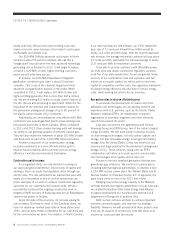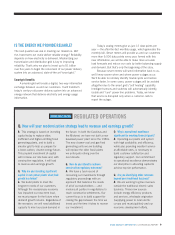Duke Energy 2009 Annual Report Download - page 19
Download and view the complete annual report
Please find page 19 of the 2009 Duke Energy annual report below. You can navigate through the pages in the report by either clicking on the pages listed below, or by using the keyword search tool below to find specific information within the annual report.
18 DUKE ENERGY CORPORATION / 2009 ANNUAL REPORT
The following is the detail of the $(0.03) per share in
special items and mark-to-market in Commercial Power
impacting adjusted diluted EPS for 2007:
2007
Diluted
Pre-Tax Tax EPS
(In millions, except per-share amounts) Amount Effect Impact
Costs to achieve the Cinergy merger $(54) $19 $(0.03)
Convertible debt costs associated with
the spinoff of Spectra Energy (21) — (0.02)
IT severance costs (12) 4 —
Settlement reserves and adjustments 24 (9) 0.01
Mark-to-market impact of economic hedges 13 (5) 0.01
Total Adjusted EPS impact $(0.03)
2010 Adjusted Diluted EPS Outlook
Duke Energy’s 2009 Annual Report references Duke Energy’s
forecasted 2010 adjusted diluted EPS outlook range of
$1.25-$1.30 per share and the 2009 EPS incentive target of
$1.20 per share. The EPS measure used for employee incentive
bonuses is primarily based on adjusted diluted EPS. Additionally,
reference is made to the forecasted range of growth of 4%-6%
in adjusted diluted EPS (on a compound annual growth rate
(“CAGR”) basis) from a base of adjusted diluted EPS for 2009
of $1.22. Adjusted diluted EPS is a non-GAAP financial
measure as it represents diluted EPS from continuing operations
attributable to Duke Energy Corporation shareholders, adjusted
for the per-share impact of special items and the mark-to-market
impacts of economic hedges in the Commercial Power segment.
Special items represent certain charges and credits, which
management believes will not be recurring on a regular basis,
although it is reasonably possible such charges and credits could
recur. Mark-to-market adjustments reflect the mark-to-market
impact of derivative contracts, which is recognized in GAAP
earnings immediately as such derivative contracts do not qualify
for hedge accounting or regulatory accounting treatment, used
in Duke Energy’s hedging of a portion of the economic value
of its generation assets in the Commercial Power segment
(as discussed separately under “Adjusted Diluted Earnings per
Share (‘EPS’)”). The most directly comparable GAAP measure
for adjusted diluted EPS is reported diluted EPS from continuing
operations attributable to Duke Energy Corporation common
shareholders, which includes the impact of special items
and the mark-to-market impacts of economic hedges in the
Commercial Power segment. Due to the forward-looking
nature of this non-GAAP financial measure for future periods,
information to reconcile it to the most directly comparable
GAAP financial measure is not available at this time, as
management is unable to project special items or mark-to-
market adjustments for future periods.
Forecasted Adjusted Segment EBIT and Other Net Expenses for 2010
Duke Energy’s 2009 Annual Report includes a discussion
of forecasted 2010 adjusted EBIT for each of Duke Energy’s
reportable segments as a percentage of forecasted 2010
adjusted total segment EBIT. The primary performance measure
used by management to evaluate segment performance is
segment EBIT from continuing operations, which at the segment
level, represents all profits from continuing operations (both
operating and non-operating), including any equity in earnings
of unconsolidated affiliates, before deducting interest and taxes,
and is net of the income attributable to non-controlling interests.
Management believes segment EBIT from continuing operations,
which is the GAAP measure used to report segment results,
is a good indicator of each segment’s operating performance
as it represents the results of Duke Energy’s ownership interests
in continuing operations without regard to financing methods
or capital structures. Duke Energy also uses adjusted segment
EBIT and adjusted Other net expenses (including adjusted equity
earnings for Crescent Resources) as a measure of historical and
anticipated future segment and Other performance. When used
for future periods, adjusted segment EBIT and adjusted Other
net expenses may also include any amounts that may be
reported as discontinued operations or extraordinary items.
Adjusted segment EBIT and Other net expenses are non-
GAAP financial measures as they represent reported segment
EBIT and Other net expenses adjusted for the impact of special
items and the mark-to market impacts of economic hedges in
the Commercial Power segment. Special items represent certain
charges and credits, which management believes will not be
recurring on a regular basis, although it is reasonably possible
such charges and credits could recur. Mark-to-market
adjustments reflect the mark-to-market impact of derivative
contracts, which is recognized in GAAP earnings immediately
as such derivative contracts do not qualify for hedge accounting
or regulatory accounting, used in Duke Energy’s hedging of a
portion of the economic value of certain of its generation assets
in the Commercial Power segment (as discussed above under
“Adjusted Diluted Earnings per Share (‘EPS’)”). Management
believes that the presentation of adjusted segment EBIT and
adjusted Other net expenses provides useful information to
investors, as it provides them an additional relevant comparison
of a segment’s or Other’s performance across periods. The most
directly comparable GAAP measures for adjusted segment EBIT
and Other net expenses are reported segment EBIT and Other
net expenses, which represent segment and Other results from
continuing operations, including any special items and the
mark-to-market impacts of economic hedges in the Commercial
Power segment. Due to the forward-looking nature of this
non-GAAP financial measure for 2010, information to reconcile
it to the most directly comparable GAAP financial measure
is not available at this time, as management is unable to project
special items or mark-to-market adjustments for future periods.
NON-GAAP FINANCIAL MEASURES (CONTINUED)
















